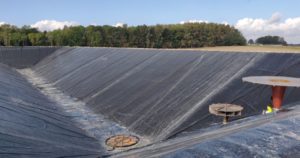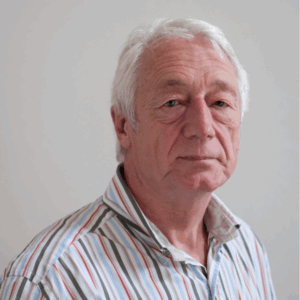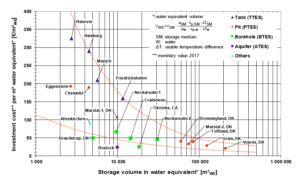New developments in geomembranes for pit heat storages
September 29, 2023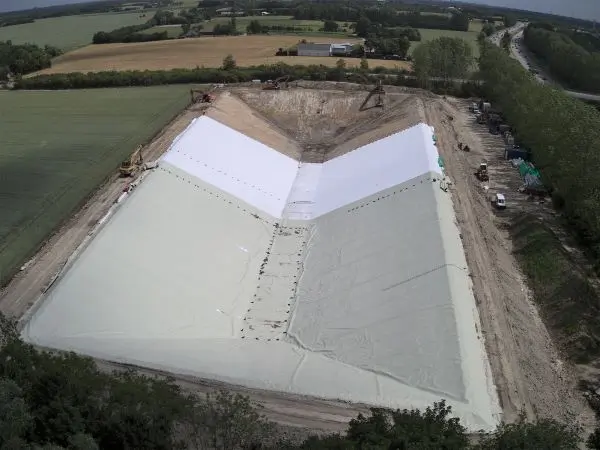
Large solar thermal systems need large heat storage capabilities. Especially if the solar heat is to contribute significantly more than 25 % to a district heating network. Pit thermal energy storage (PTES) is a cost-effective way to build large heat storage facilities with 100,000 m3 and more. A key component of these storage pits is the polymeric geomembrane that forms the seal between the pit and the ground. It must have good resistance to high temperatures. We interviewed the few manufacturers of these geomembranes and present new projects and new developments here. The photo shows the installation of the grey geomembrane at the storage facility in Høje Tåstrup in Denmark – a newly developed liner made of polypropylene thermoplastic.
Photo: DTU / Ioannis Sifnaios
Worldwide, the number of manufacturers of such geomembranes is low. In 2017, the Solmax Group, based in Varennes, Canada, bought the American company GSE Environmental, which also included the Hamburg-based company GSE Lining Technology. GSE had equipped a number of solar thermal heat storage pits in Denmark and China with black geomembranes (see photos below).
This gave rise to Solmax Geosynthetics, which supplied the geomembranes for a seasonal storage facility in Meldorf, Germany, the construction of which began in autumn 2022. Here, industrial waste heat from a printing plant and a biogas plant will be stored. Another manufacturer is Agru Kunststofftechnik from Bad Hall in Austria. Agru equipped the Danish project Høje Tåstrup with polymeric geomembranes. This PTES, which started operation in spring 2023, uses waste heat from biomass-fuelled cogeneration and waste incineration for district heating (see photo at the top of the article).
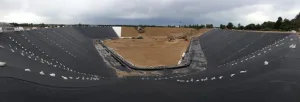
First generation of geosynthetic geomembranes in seasonal storage, here in Vojens, Denmark, built in 2014 Photo: Solmax Geosynthetics (GSE Environmental)
The third supplier, Layfield Group, is also headquartered in Canada. The company supplied the geomembranes for a storage pit in Australia in 2022. It is used to store waste heat from a solar thermal tower power plant, which is used in an ORC process to generate electricity. According to Hendrik Wetzel, storage expert from the Danish planning office Planenergi, other companies such as Sotrafa, Spain, or Juta, Czech Republic, produce temperature-resistant geomembranes, but have not supplied any seasonal storage projects in recent years. Planenergi has provided planning and scientific support for many of the Danish solar thermal storage pits, including the Høje Tåstrup project.
Sealing in several layers
PTES are sealed in several layers. First, a protective erosion-control layer is placed on the stone-free and compacted subsoil – the construction bed. “The protective layer has to be matched to the type of subsoil and the base material for the geosynthetics,” said Thomas Labda, Key Account Manager for Renewable Energy at Solmax Geosynthetics. The temperature-resistant polymer membrane is then placed on top of the protective layer. This also seals the storage water in an upward direction as it is used for the bottom layer of the insulated floating cover.
“In addition to a permanent leakage-control system, and a mineral secondary barrier can be used, which prevents water seepage in the event of a leak,” said Markus Seume, responsible for geomembrane sales at Krefeld-based G quadrat. The company acts as a system provider for PTES solutions and works closely with Agru Kunststofftechnik. For this purpose, G quadrat recommends the material Trisoplast. This is a sand-bentonite-polymer mixture that is installed in a thickness of 8 cm below the protection and drainage layer. According to Seume, this material also meets the requirements in water-protection areas.
Guideline for weld seams
Solmax Geosynthetics typically manufactures its geomembranes in a width of 7.5 m and length of 80 m. The company designs the thickness of the membranes based on the intended operating temperature profile and the required lifetime. “As a rule, most of the PTES in recent years have been realized with a material thickness of 2.5 mm,” says Labda.
The installation of the overall sealing system is typically carried out according to the high German standards from landfill construction, which includes a weld seam test according to DVS, the German Association for Welding and Allied Processes, according to Solmax Geosynthetics. Wetzel from Planenergi points out that the quality of a weld seam made on site between the individual geomembranes depends on parameters such as temperature and humidity. “There is a natural welding window, so to say, which without additional measures is basically smaller in winter or can be completely absent during the course of the day,” said Wetzel.
Temperature load depends on storage operation
In most of the projects implemented so far, special geomembranes made of high-temperature-resistant polyethylene (HTR-PE) are used. In Høje Tåstrup, the membranes are based on polypropylene (PP). Agru Kunststofftechnik developed this new type of geomembrane together with the IPMT (Institute of Polymeric Materials and Testing) at the Johannes Kepler University in Linz, Austria. The aim of the development was to improve the long-term resistance at higher temperatures.
With classic solar thermal seasonal storage pits, there is only one cycle per year, as in the Danish pioneer project Marstal. It is typically loaded in summer and unloaded in winter. This means that the maximum temperature load of up to 90 °C for the geomembranes only occurs over a relatively short period in late summer. The situation is different at the Høje Tåstrup PTES, which is intended to be used for multifunctional operation as weekly storage. “Høje Tåstrup is designed for 20 to 25 cycles per year, as it takes 4 days to load the storage and another 4 days to unload it,” says storage expert Wetzel. “The basic prerequisite for multifunctional operation is permanently high temperatures, at least in the uppermost water layer and thus in direct contact with the floating geomembrane as the lowest layer of the insulating cover.”
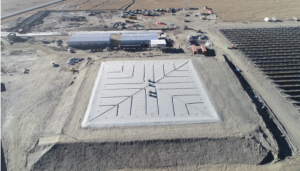
Construction of a 15,000 m3 pit heat storage in Langkazi, Tibet, China, built in 2018. The water-filled pit was covered with a geomembrane from Solmax Geosynthetics before adding the insulated accessible cover. Photo: Solmax Geosynthetics
Improved service life at high temperatures
These requirements are to be met by the new PP-HTR membranes, according to Agru Kunststofftechnik. The material’s higher melting point compared to PE is said to allow higher temperature profiles and lead to longer system lifetimes. “By using PP membranes with customized additional stabilisers, it becomes possible to achieve a service life of more than 25 years at continuous temperatures of more than 95 °C,” said Franz Luhamer, Sales Manager Special Waterproofing at Agru Kunststofftechnik. The longer service life would also improve profitability.
Solmax Geosynthetics is currently working on the Efficient Pit research project, funded by the German Ministry of Economics, to develop new formulations and products to improve the properties of the temperature-resistant geomembranes. Labda does not rule out using polypropylene-based geomembranes in the future. “But at the moment our focus remains on PE,” says Labda. This material is easier to weld and also suitable for multifunctional operation.
Both Solmax Geosynthetics and Agru Kunststofftechnik reported that they are involved in planning and feasibility studies for further PTES in Germany and Europe, but neither company mentioned specific projects.
Websites of organizations mentioned in this news article:
Solmax Geosynthetics GmbH: https://www.solmaxgeosynthetics.de/
agru Kunststofftechnik Gesellschaft m.b.H.: https://www.agru.at/en/
G quadrat GmbH: http://www.gquadrat.de
Layfield Group: https://www.layfieldgroup.com/
Sotrafa S.A.: https://sotrafa.com/en/
Juta a.s.: https://www.juta.eu/
